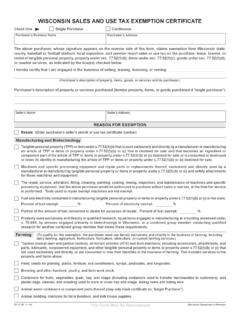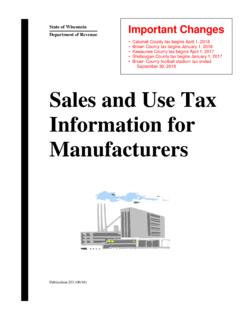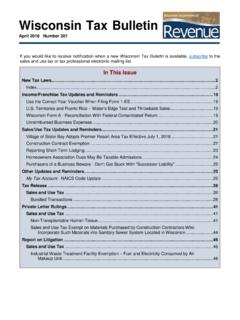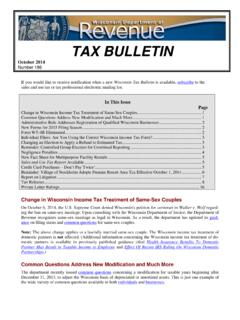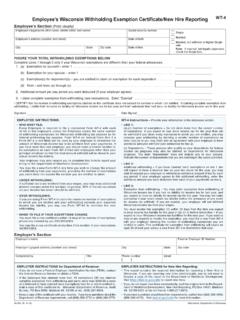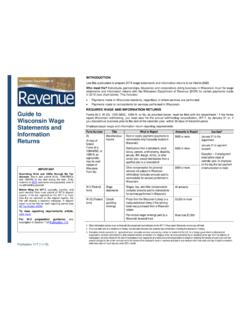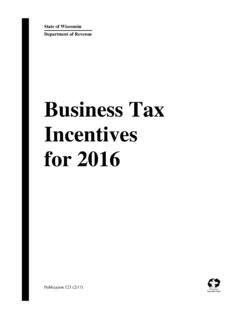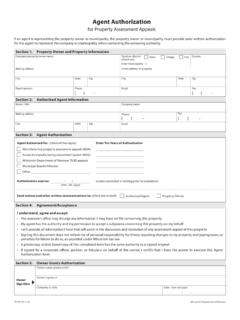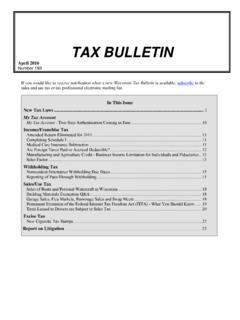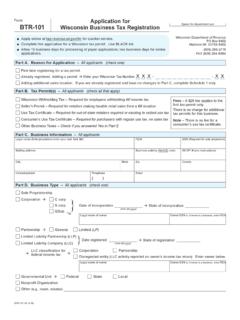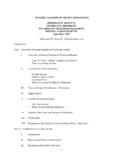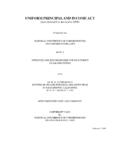Transcription of 2018 Guide for Property Owners
1 2018 Guide for Property Owners (R. 1-18) Back to table of contents2 2018 Guide for Property Owners Wisconsin Department of RevenueTable of Contents I. Introduction .. 3II. General Property .. 3 A . Real Property , real estate and land .. 3 B . Personal Property .. 3 C . Taxable/nontaxable Property .. 4 D . Uniform Property tax .. 4 III. Assessment and Its Purpose .. 4I V. Assessors .. 6 A . Certification .. 6 B . Wisconsin Property Assessment Manual (WPAM) .. 6V. Assessment Process .. 7 A . Municipal assessor is responsible for the assessment process.
2 7 B . Assessment classification .. 7 C . Property information .. 8 D . Equitable assessment .. 9 E . Notice of changed assessment .. 10 F . Assessment roll .. 10 G . Assessment questions .. 11 H . Open Book .. 11VI. Board of Review (BOR) .. 12 A . Appealing your assessment .. 12 B . Providing information to the BOR .. 13 VII. Reassessment/Revaluation .. 17 A . Initiating a reassessment .. 17 B . Supervised assessment .. 17 C . Initiating a revaluation .. 17 D . Trespassing and Revaluation Notice .. 18 E . Sample Revaluation Notice .. 19 VIII.
3 Levy and Rates .. 19 A . Tax rate .. 19 B . General Property tax bill .. 20 C . School taxes .. 20 Back to table of contents3 2018 Guide for Property Owners Wisconsin Department of RevenueanchorIX. Collection .. 20 A . Property tax bills .. 20 B . Payment of Property taxes .. 20 C . Interest on unpaid taxes .. 21 D . Unlawful tax claim .. 21 E . Excessive assessment claim .. 21 F . Denial of unlawful tax or excessive assessment claim .. 22X. Assistance with Property taxes .. 22 A . Homestead tax credit .. 22 B . Property tax deferral loan program.
4 22 C . Assistance for the elderly .. 23 D . Property tax exemption for veterans .. 23XI. Real Estate Property Tax Bill .. 24 XII. Tax Rate .. 27 XIII. Special Purpose Costs .. 27 XIV. Payment Procedures .. 27X V. Definition of Terms .. 28 XVI. Contact Information .. 30I. IntroductionThis Guide provides general information about Property assessment and taxation . Contact your local assessor for information about your Property assessment and your local clerk for information about your Property taxes .II. General PropertyDefined by state law, general Property includes all taxable real and personal Property , except Property taxed under special provisions (ex: utility, forest crop, woodland tax, and managed forest Property ).
5 A. Real Property , real estate and landThe land and all buildings, improvements, fixtures, and rights and privileges connected with the land .B. Personal propertyAll goods, wares, merchandise, chattels and effects of any nature or description having any marketable value and not included in real Property .Back to table of contents4 2018 Guide for Property Owners Wisconsin Department of RevenueC. Taxable/nontaxable propertyAll Property is taxable unless exempted by state law. Common Property types exempt by state law: State and municipal Property Public and private school Property Cemeteries Property used for abatement of air and water pollution Household furniture and furnishings Manufacturing machinery specific processing equipment Apparel and musical instruments for personal use Money, bonds and stocks Motor vehicles and aircraft Livestock, inventories and merchant s stocks Computers and electronic peripheral equipmentD.
6 Uniform Property taxArticle VIII of the State Constitution requires the uniform taxation of Property . Article VIII also provides the following Property taxation standards: Legislature prescribes taxes on forest Property Taxation of agricultural land and undeveloped land does not need to be uniform with the taxation of other real propertyThe state legislature enacts all Property tax and assessment laws . The Property tax assessment laws are covered in Chapter 70 of the Wisconsin Statutes .III. Assessment and Its PurposeAn assessment is the value an assessor places on your Property . This value determines what portion of the local Property tax levy is covered by your Property .
7 General Property tax componentsThere are two basic components in any tax, the base and the rate . Multiplying the base times the rate, determines the tax amount .1. Property tax base/rateThe base is the value of all taxable Property in the district . The clerk calculates the rate after the governing body of the town, village or city determines how much money must be raised from the Property tax . In Wisconsin, the town, village,or city treasurer collects Property taxes for the municipality, the school, the county and the state .The assessor of each taxation district determines the assessed value of all taxable Property , with the exception of manufacturing Property .
8 The Wisconsin Department of Revenue (DOR) annually assesses all manufacturing Property in the state . The assessor is appointed or elected at the local level . Back to table of contents5 2018 Guide for Property Owners Wisconsin Department of Revenue2. Assessed value vs. equalized valuea. Assessed valueThe value the local assessor places on each real Property parcel and on each individual s taxable personal Property . Under state law, all non-agricultural assessments must be based on the Property s market value as of January 1 . State law recognizes that every municipality cannot be assessed exactly at market value each year.
9 The law requires that each municipality is within 10 percent of market value once every five years . Assessed values are used to distribute the municipality s tax burden among the individual Property Owners .b. Equalized valueIt is necessary for the DOR to determine an equalized value by taxing jurisdiction . Equalized values are needed since Property is assessed in different taxing districts at different percentages of market value . Uniform values are called equalized values because local levels of assessment are equalized and all non-agricultural Property are valued on an equal basis, namely 100 percent of market value.
10 The equalized values are used for apportioning county Property taxes, public school taxes, vocational school taxes and for distributing Property tax relief .Note: The assessed value is important for maintaining equity among individual taxpayers within the municipality while the equalized value maintains equity between municipalities and counties . c. Uses of equalized valueEqualized values are used by the taxing jurisdictions (ex: school districts, counties, state) to apportion their tax levies among municipalities . Apportioning is the process of dividing the tax levies for each taxing jurisdiction among all of the municipalities that contain territory in the jurisdiction, based on each district s total value.
